Torque vs Work
PLEASE DO NOT EDIT THIS PAGE.
- UNDER CONSTRUCTION***********
- UNDER CONSTRUCTION***********
- UNDER CONSTRUCTION***********
- UNDER CONSTRUCTION***********
- UNDER CONSTRUCTION***********
- UNDER CONSTRUCTION***********
- UNDER CONSTRUCTION***********
- UNDER CONSTRUCTION***********
- UNDER CONSTRUCTION***********
- UNDER CONSTRUCTION***********
JeremyMD
When it comes to our universe, there still remains much that we do not understand. That we we do know and understand, we measure in relation to other ideas or subjects, in terms of abstracts we call units. In modern physics, and most mathematical applications we relate and measure matter and interactions in terms of these units. However, two such descriptions having the same units does necessarily connotate a representation of the same idea or measurement. Here, we will examine one such occurrence in modern physics, specifically the difference between torque and work when both are expressed as Newton*meters.
The Newton-Meter --> Vector vs Scaler
State, in your own words, the main idea for this topic
In modern physics, there a two concepts that, while describing different ideas, happen to utilize the same units, these units being:
[math]\displaystyle{ Newton * meters }[/math] [math]\displaystyle{ (N * m) }[/math]
The first of these concepts is torque, which is a measurement of the moment that a force causes in a system. A moment is also known as a system's tendency of a force to cause rotation.

[math]\displaystyle{ \vec{\tau} = \vec{F} X \vec{r}_{cm} }[/math]
where \tau is the vector cross product of the force vector and position vector relative to the center of mass
The second concept is work, which is the measurement of a force acting over a distance on a given system.

[math]\displaystyle{ W = \vec{F}*\vec{r} }[/math]
where W is the scaler dot product of the force vector and change in position vector
Both of these concepts are measured using the units of [math]\displaystyle{ Newton * meters }[/math]
Previously, when we addressed the energy principle and energy in general, we describe the measurement of energy and change in energy in:
[math]\displaystyle{ Joules }[/math] [math]\displaystyle{ (J) }[/math]
As it happens, work on a system is also equivalent to the change in kinetic energy of a system and can therefore also be expressed in joules. Positive work will add kinetic energy to a system whereas negative work will subtract kinetic energy from a system.
[math]\displaystyle{ W = ∆K = K_{final} - K_{initial} }[/math]
where W is the work done and K is the kinetic energy of the system.
A Mathematical Model
What are the mathematical equations that allow us to model this topic. For example [math]\displaystyle{ {\frac{d\vec{p}}{dt}}_{system} = \vec{F}_{net} }[/math] where p is the momentum of the system and F is the net force from the surroundings.
A Computational Model
How do we visualize or predict using this topic. Consider embedding some vpython code here Teach hands-on with GlowScript
Examples
Be sure to show all steps in your solution and include diagrams whenever possible
Simple
Middling
Difficult
Connectedness
- How is this topic connected to something that you are interested in?
- How is it connected to your major?
- Is there an interesting industrial application?
History
Put this idea in historical context. Give the reader the Who, What, When, Where, and Why.
See also
Are there related topics or categories in this wiki resource for the curious reader to explore? How does this topic fit into that context?
Further reading
Books, Articles or other print media on this topic
External links
References
This section contains the the references you used while writing this page